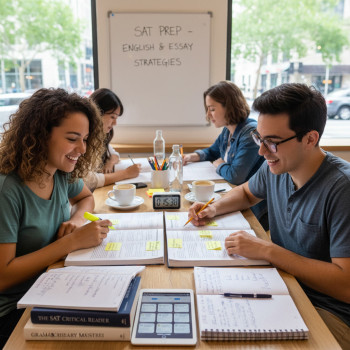How to Avoid Burnout by Mixing Fun Into Your Digital SAT Prep
Intro: Why ‘fun’ is a study strategy, not a luxury
Picture this: it’s midnight, you’re crouched over another practice section, your eyes are gritty, and your focus resembles a flickering phone battery icon. Sound familiar? Burnout during SAT prep is real — and it’s sneaky. It creeps in when studying becomes a marathon of drills without variety, rewards, or a single laugh. But here’s the good news: mixing fun into your preparation is not indulgence; it’s science-based, practical, and one of the most effective ways to improve retention, sustain motivation, and arrive at test day calm and ready.
This post is for the student who wants top performance without sacrificing sanity. It walks through how to intentionally weave enjoyable activities into your Digital SAT routine, gives concrete examples and a sample weekly plan, and even suggests how to use personalized help like Sparkl’s tutoring when you need structure that fits your life. Let’s make studying something you can live with—and maybe even enjoy.
Understanding burnout: what it looks like and why it matters
Burnout on test prep often looks like this:
- Chronic fatigue and dread about studying
- Decreased efficiency — longer study hours for less progress
- Procrastination and avoidance of practice tests
- Blunted motivation and test anxiety
Why it matters: burnout rewires your approach to learning. Instead of curiosity and incremental growth, you get fatigue-driven study habits: shortcuts, shallow review, and panic before big practice tests. The remedy is to design a plan that alternates intensity with recovery, challenge with play, and skill-building with celebration.
Principles for mixing fun into serious prep
1. Treat fun as fuel, not a reward you’ll rarely reach
Many students save fun for ‘after the final practice test’ and then never get there. Instead, schedule short, consistent pleasures into your study blocks—tiny things that reset your brain. The trick is to make enjoyment predictable so it becomes part of the habit loop that drives studying forward.
2. Use active play to strengthen learning
Fun activities that are barely related to the SAT (watching a show, scrolling social media) restore energy, but the most powerful boosters are playful activities that still connect to learning: competitive vocabulary games, math puzzles, or a debate night with friends about a mock passage. These keep your brain in the same skill-set neighborhood while giving it a different entrance.
3. Follow the work–rest rhythm
Your brain needs cycles of focused work and meaningful rest. One durable method is to alternate high-intensity practice with low-effort, enjoyable recovery. The goal: avoid cognitive depletion while maintaining momentum.
Concrete, enjoyable strategies to add into your routine
Micro-fun: tiny resets that keep you going
- 5-minute dance break or quick walk outside after a 25–40 minute session.
- Snack ceremony: pick a small, tasty snack you only allow during study breaks.
- Music swap: create a playlist for ‘study on’ and a contrasting playlist for ‘celebrate’ moments.
Meso-fun: weekly habits that spice your plan
- Practice-test party: make one practice test social (with friends remotely or in person) and celebrate afterward—pizza, a short movie, or an escape-room challenge.
- Gamify vocabulary learning: use flashcards for speed rounds and award points; keep a leaderboard with a friend.
- Theme days: “Math Monday, Reading Friday” but with themed rewards—Math Monday might end with a coffee run; Reading Friday ends with a poetry slam or fiction hour.
Macro-fun: built-in recovery and goals
- Schedule one full day off per week where no SAT is allowed—zero review, zero guilt.
- Plan a mid-prep day trip or outdoor activity after a hard practice-test week.
- Set non-score goals (finish a timing technique, master a problem type) and reward milestones with bigger treats.
Example weekly plan: blending rigor and delight
Here’s a practical template you can adapt. It assumes 10–12 hours of weekly SAT prep split across short daily sessions plus one full-length practice test.
| Day | Study Focus | Session Structure | Fun Element |
|---|---|---|---|
| Monday | Math (problem types) | 4 × 30-min focused blocks with breaks | 5-min dance break between blocks |
| Tuesday | Reading comprehension | 2 × 45-min passages; 15-min review | Reading playlist + warm tea |
| Wednesday | Practice quiz + solutions | Timed quiz (50–60 min) + analysis | Quick walk or coffee with a friend |
| Thursday | Writing & Language | Timed sets + error log work | 5-min word-game challenge |
| Friday | Targeted review (weak spots) | Short, focused drills (2 × 40 min) | Movie night or gaming session |
| Saturday | Full-length practice test (Bluebook) | Practice test + scoring + reflection | Post-test treat: brunch or outing |
| Sunday | Recovery + light review | 30–60 minutes: flashcards + planning | Complete rest—no SAT talk |
This plan balances intensity and joy. The full-length test day is intense by design—but the rest of the week includes lighter, playful touch-points so you don’t arrive exhausted.
Study techniques that feel like play
1. Competitive study games
Bring a friend or small study group into play. Turn vocabulary into a rapid-fire quiz, race to solve a problem set, or hold a 20-minute ‘proofreading showdown’ for Writing & Language. The social element increases accountability and makes practice memorable.
2. Storytelling for reading passages
Treat dense passages like mini-stories. After reading, try to retell the passage in three sentences. This active reconstruction solidifies comprehension and feels like a creative task rather than a dry drill.
3. Puzzles and lateral thinking
Logic puzzles, Sudoku, and brainteasers improve pattern recognition and mental stamina in an enjoyable way. Spend 10–15 minutes daily solving a puzzle; it refreshes problem-solving skills that transfer to tricky math questions.
Practical tips: scheduling, focus, and energy
Use the 50/10 rule — and tweak it
Try 50 minutes of focused study followed by a 10-minute break. If 50 feels long, start at 25/5 and build up. The key is predictability: your brain relaxes when it knows a break is coming.
Prioritize sleep, hydration, and movement
No amount of gamified studying substitutes for rest. Aim for consistent sleep and simple movement—10 minutes of stretching or walking improves concentration more reliably than cramming through exhaustion.
Switch contexts to reduce monotony
Study in different places: library booths, a café corner, a park bench. New environments can make routine tasks feel novel and keep your brain engaged.
When to get help: using personalization wisely
Sometimes, burnout is a symptom of an inefficient plan—not lack of effort. If you’re stuck in a cycle of long hours and low returns, personalized support can reset your trajectory.
- Consider 1-on-1 guidance when self-study becomes frustrating; a tutor can diagnose weak spots fast.
- Tailored study plans minimize wasted hours by focusing on the highest-impact skills for your score goals.
- Expert tutors can model pacing strategies and techniques for the digital format, especially with Bluebook practice tests.
For many students, Sparkl’s personalized tutoring is a natural fit: their 1-on-1 approach, tailored study plans, and expert tutors can identify your sticking points and fold enjoyable, skill-building practice into your schedule. If you want AI-driven insights or a study plan that actually fits your life, consider blending structured tutoring sessions with the playful strategies outlined here.
Real-world examples and mini case studies
Case study 1: Maya — the overworker who learned to micro-play
Maya was burning through 5–6 hour nights of study, but scores weren’t budging. We helped her compress study into two high-impact hours per night using focused blocks and micro-fun resets. She replaced one passive review hour with a 20-minute competitive vocabulary session with a friend. Her practice-test accuracy improved, and she stopped dreading study time.
Case study 2: Jamal — the procrastinator who made prep social
Jamal avoided practice tests. We converted practice into a social event: every Saturday morning, he and two classmates took a timed practice section and met afterward to analyze tricky questions over brunch. The social routine reduced avoidance and helped him learn faster through peer explanations.
Handling high-pressure weeks (midterms, holidays, or school projects)
During weeks when life is busy, shorten study blocks and reduce frequency rather than stop completely. Even 20 minutes of targeted practice keeps memory fresh and prevents the ‘restart friction’ that comes from long gaps. Keep the fun simple: a 10-minute puzzle, a quick walk, or listening to a favorite song after a focused session is enough.
Tools and resources to make study feel less like a grind
- Bluebook practice tests — simulate the digital test environment to reduce test-day anxiety.
- Personalized tutoring — schedule targeted sessions to fix one problem type at a time.
- Gamified apps and flashcard tools — make repetition quick and rewarding.
Sample month plan: build momentum without burning out
Below is a 4-week outline that balances skill building, practice tests, and recovery. Tweak durations to fit your schedule.
| Week | Focus | Key Activities | Fun Anchor |
|---|---|---|---|
| Week 1 | Foundation: content and timing | Short daily blocks, diagnostic test, start error log | Host a study playlist swap with friends |
| Week 2 | Target weaknesses | Drills on weak topics, one timed section every other day | Mini celebration for every completed weeknight goal |
| Week 3 | Practice test & review | Full-length Bluebook test, deep review of missed items | Post-test outing (movie or outdoor activity) |
| Week 4 | Polish & light practice | Targeted practice, strategy refresh, sleep prioritization | Weekend day off—no SATs |
What to do the day before a full-length practice test
- Limit study to a light review of formula sheets and an error log—no new material.
- Do a short, low-pressure mental warm-up (10–15 minutes of puzzles or a practice section).
- Plan a tangible, enjoyable reward for test completion and a full recovery night of sleep.
How to measure progress without pressure
Replace obsessive score-chasing with a few healthier metrics:
- Consistency: number of focused sessions per week.
- Mastery of problem types: percentage of previously-missed questions you now get right.
- Energy levels: subjective check-ins—do you feel less drained after study sessions?
Use these to guide adjustments. If your score jumps are slow but consistency and mastery are improving, you’re on the right track.
When fun backfires—and how to fix it
Sometimes fun becomes avoidance. If you find yourself choosing fun over study consistently, try these fixes:
- Timebox your fun. Make the reward contingent on a completed session.
- Switch to active fun that supports learning (e.g., vocabulary games instead of passive scrolling).
- Limit highly absorbing rewards (social media, long shows) to after major milestones, not 5-minute breaks.
Final thoughts: sustainable preparation wins
Preparing for the Digital SAT is a marathon of skill, strategy, and mindset. If you only optimize for hours, you risk burnout. If you only optimize for joy, you risk under-preparation. The sweet spot is a balanced plan that treats fun as an essential ingredient—not an afterthought.
Start small: pick one micro-fun habit and one meso-fun weekly tradition, and pair those with a clear study structure. If you ever feel stuck, consider personalized help that molds a plan to your life—Sparkl’s 1-on-1 tutoring and tailored study plans are designed to help students study smarter, not harder, and can fold those fun elements into a strategy that moves your score forward while protecting your mental health.
Remember: the best prep is the kind you can sustain. Keep curiosity, kindness to yourself, and a dash of play in your calendar. You’ll learn more, stress less, and maybe even enjoy the ride.
Quick checklist to end with
- Schedule consistent study blocks and one full day off weekly.
- Mix micro- and meso-fun into your plan (short breaks + themed rewards).
- Use playful study techniques: games, storytelling, puzzles.
- Track consistency and mastery—not just raw scores.
- Consider targeted 1-on-1 support if you’re stuck; get a plan that includes enjoyment and recovery.
Go forward
Switch the mental image of SAT prep from slog to a series of manageable, meaningful, and occasionally delightful steps. With intentional structure and a few well-placed moments of fun, you’ll protect your mental health and sharpen your performance. Now take a breath, pick one playful change, and try it tomorrow—consistency plus joy is a powerful combination.













No Comments
Leave a comment Cancel